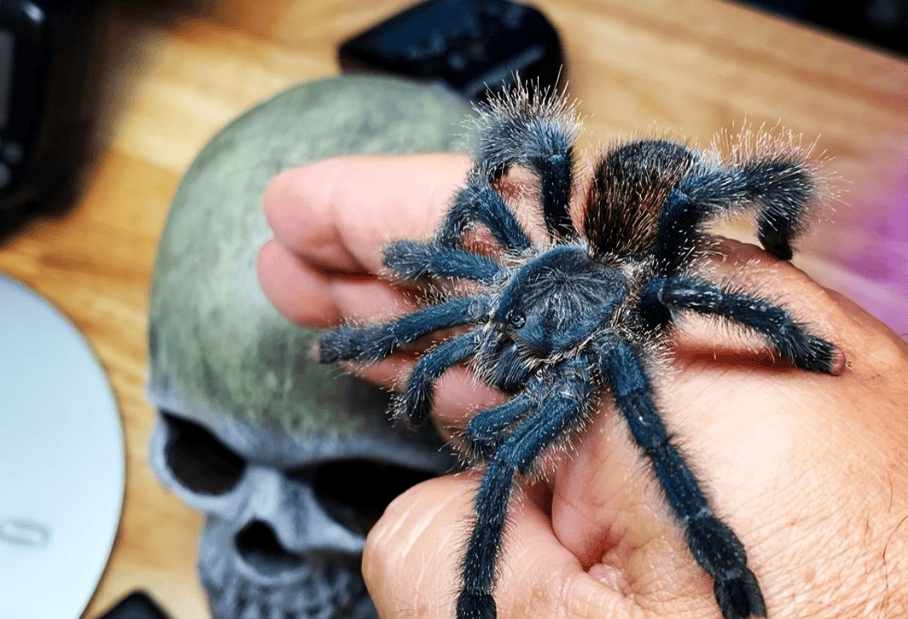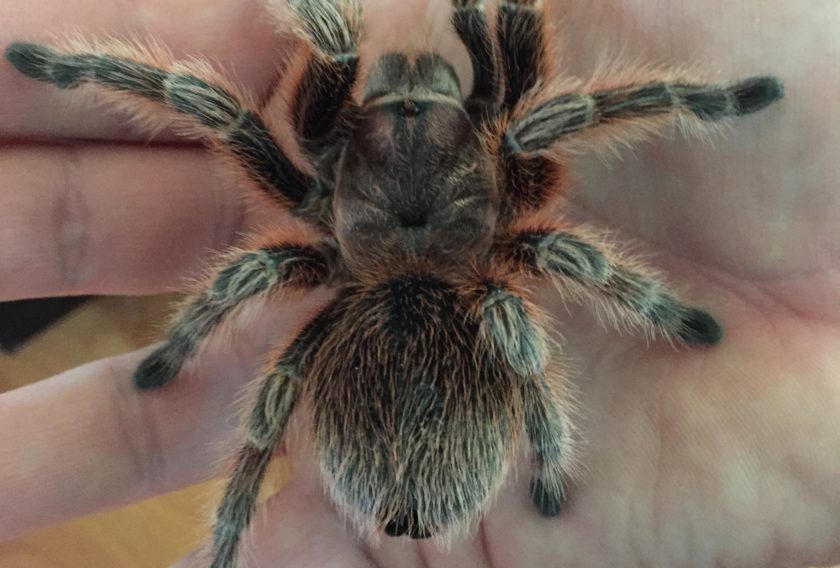Handling tarantulas may be desirable for some keepers while it can be a challenging task for others. Tarantulas, with their impressive size and sometimes intimidating appearance, often evoke fear and fascination in people. Once you overcome your arachnophobia, handling your tarantula can be a thrilling experience.
However, these creatures are not as dangerous as they may seem initially. In fact, with the right knowledge and precautions, handling tarantulas can be a safe and rewarding experience. Let’s delve into the myths, facts, and precautions surrounding tarantula handling and provide guidance on how to do it safely and responsibly.
Understanding Tarantulas Behavior
To begin with handling, you should be first acquainted with basic tarantula behavior, including defensive postures, warning signs of stress, and indications of readiness to handle. Moreover, you should use soft foam-tipped forceps rather than bare hands to guide the movements of your tarantula.

Tarantulas are large, hairy spiders belonging to the Theraphosidae family. They are found in various parts of the world, from deserts to rainforests. Despite their often fearsome appearance, most tarantula species are relatively harmless to humans.
Some species such as Chaco Golden Knee, Chilean Rose Tarantula and Curly hair tarantulas are popular due to their docile temperament.

While all of them possess venom to subdue their prey, their venom is typically no more potent than a bee sting and is not considered dangerous to healthy adults. However, some individuals may have allergic reactions to tarantula venom, so it’s essential to handle them with care.
Species-specific Considerations
Different tarantula species may have unique temperaments and handling requirements, so it is important to research the specific species you are interested in handling or keeping as a pet.
As per experience and personal choice, some species can be considered good for handling.
Best Beginner Friendly tarantulas for Handling are
Tarantulas Requiring Experience Handling
- Brazillian Salmon Pink Bird Eater
- Goliath Bird eater
- Orange Baboon
- Cobalt Blue
- Sun Tiger
Preparation
The preparation for handling your tarantula requires suitable handling containers, tools (such as soft brushes or tongs), and a calm environment free from distractions along with approaching techniques.

Approaching the Tarantula
You should approach your tarantula calmly as sudden movements and loud noises can startle your tarantula and it may trigger a defensive response. Therefore slow and gentle movements are recommended.
Handling Techniques
These are some of the techniques which help in handling your tarantula with ease.
Use A Soft Brush Or Forceps
When handling a tarantula, it’s best to use a soft brush or paintbrush to gently coax it out of its enclosure.The tarantulas should be handled with soft foam-tipped forceps rather than bare hands. Avoid using your hands, as this can cause unnecessary stress to the spider and increase the risk of being bitten.

Support the Tarantula’s Body
When lifting a tarantula, you should support its body and legs to prevent it from falling or becoming injured. You should use gentle and steady movements to minimize stress on the spider.
Know When to Stop
You should pay attention to the tarantula’s behavior during handling. If it becomes agitated or defensive, gently return it to its enclosure and give it space to calm down.

Respecting Boundaries
You should respect the tarantula’s boundaries and not force handling if the tarantula shows signs of stress or aggression.
Duration of Handling
The handling sessions should be short so as not to trigger any unpleasant response from your eight-legged companion. You can gradually increase handling time to acclimate your tarantula to human interaction.
Monitoring the Tarantula’s Response
You should observe the tarantula’s behavior during handling and be prepared to end the session if the tarantula shows signs of stress.
Building Trust
Regular and gentle handling can help to build trust between the tarantula and the handler over some time. So you should be patient with your tarantula.

Handling Risks
There are potential risks associated with handling tarantulas, such as accidental falls or bites, and you can minimize these risks by taking certain precautions. Some of the suggestive measures can be
Secure Handling Area
Make sure you’re handling the tarantula in a secure area, preferably over a soft surface like a table covered with a towel or a carpeted floor. This reduces the risk of injury if the tarantula falls.
Low Altitude
You should avoid handling the tarantula at a height. Keeping it close to the ground reduces the risk of injury if it falls.
Confined Space
Consider handling the tarantula inside a confined space, such as a bathtub or a large plastic container with tall sides. This prevents the tarantula from crawling too far or falling from a height.
Gentle Movements
You should handle the tarantula with gentle and slow movements to minimize the chances of startling or agitating it, which could cause it to fall.
Use a Catch Cup
When handling a tarantula, especially if it’s particularly skittish or prone to bolt, have a catch cup nearby. This can be a small plastic container with a lid. If the tarantula starts to fall or move unpredictably, you can quickly guide it into the catch cup to prevent injury.

Handler’s Positioning
Position your hands and body in a way that allows you to react quickly if the tarantula starts to fall. Keep your hands close to the spider but be ready to catch it or guide it to a safe location if necessary.
Know Your Tarantula
Different species of tarantulas have different temperaments and behaviors. Some are more prone to bolting or being skittish such as, Costa Rican Zebra Tarantula, while others are calmer such as Curly hair Tarantula. Understanding your tarantula’s behavior can help you anticipate and prevent accidents.
Practice and Patience
If you’re new to handling tarantulas, it’s important to practice patience and handle them in a controlled environment until you feel confident in your ability to do so safely.
Handling During Molting
Handling tarantulas during the molting process should be strictly avoided because the skin of the tarantula is quite tender and handling can cause some severe damage to your tarantula. The other alternative for interacting with the tarantula during this time can be watching from a distance.
Handling Young Tarantulas
Handling young tarantulas, or spiderlings, requires extreme caution due to their small size and fragility. It’s generally recommended that you should avoid handling them altogether and wait until they molt and grow larger before considering it.
If handling is necessary for maintenance or transferring purposes, you should use a soft paintbrush to gently coax them into a container, avoiding direct contact with your hands to prevent injury.
You should keep handling sessions brief and infrequent to minimize stress and try to approach the spiderling slowly and gently to avoid startling it.

You should ensure that their enclosure is secure to prevent escape or injury during handling. Remember to prioritize the safety and well-being of the tarantula at all times, and if in doubt, refrain from handling it altogether.
Respecting Individual Preferences
All tarantulas will not enjoy or tolerate handling, and it’s essential to respect each tarantula’s preferences and comfort level.
Dispelling Myths
One of the most common myths surrounding tarantulas is that they are aggressive and prone to biting. In reality, some species of tarantulas are typically docile creatures that would rather flee than confront a potential threat.
Biting is a last resort for them, and they will only do so if they feel extremely threatened or provoked. Additionally, tarantulas have poor eyesight and rely primarily on their sense of touch to perceive their surroundings. Therefore, sudden movements or vibrations can startle them, leading to defensive behavior.
Another misconception is that all tarantulas are venomous and deadly. While it’s true that tarantulas possess venom, the majority of species pose little to no threat to humans. Even in the rare event of a bite, the effects are usually mild and comparable to a bee sting. However, there are a few species with aggressive and skittish temperaments such as Goliath Bird Eater Tarantula which should be handled with extra caution or avoided altogether.
Do’s and Don’t while Handling
Here’s a list of do’s and don’ts for handling a tarantula:

Do’s:
- Research: Educate yourself about the specific species of tarantula you are handling, including its behavior, temperament, and defensive mechanisms.
- Approach Slowly: Approach the tarantula calmly and slowly to avoid startling it. Sudden movements can cause stress or defensive reactions.
- Use Proper Technique: When handling, gently coax the tarantula onto your hand or a soft brush using light pressure. Support its body securely to prevent falls or injuries.
- Use the proper tool: You should use a pair of soft foam-tipped forceps along with a capture cup to gently move your tarantula.
- Know Your Limits: Know your own comfort level and limitations when handling tarantulas. If you feel uneasy or unsure, it’s better to avoid handling and observe from a distance.
Don’ts:
- Don’t Startle: Avoid sudden movements, loud noises, or vibrations that could startle or stress the tarantula.
- Don’t Force Handling: If the tarantula shows signs of stress or discomfort, such as rearing up or flicking urticating hairs, it’s best to end the handling session immediately and return it to its enclosure.
- Don’t Handle During Molting: Refrain from handling a tarantula that is in the process of molting or has recently molted. Molting is a vulnerable time for tarantulas, and handling can cause severe stress or injury.
- Avoid Grasping: Never grab or squeeze a tarantula when handling it. This can injure the spider and may lead to defensive behaviors.
- Don’t Handle When Agitated: If the tarantula appears agitated, defensive, or in a threatening posture (e.g., raising its front legs), it’s best to avoid handling it altogether and allow it to calm down in its enclosure.
By following these do’s and don’ts, you can minimize stress for both yourself and your tarantula and create a safer and more positive handling experience.

Frequently Asked Questions
Question1: Is it OK to touch tarantula?
Answer: The tarantulas are generally docile and will not harm you on holding but these are not pets for cuddling. Therefore you should avoid handling a tarantula without knowing their temperament.
Question2 : Do All tarantulas like to be held?
Answer: No, all tarantulas have a different temperament and may or may not like to be held. Some tarantulas such as Chilean Rose, Curly hair tarantulas like to be held.
Question 3: Can I touch tarantula after molting ?
Answer: You should not touch the tarantula when it is undergoing the process of molting. You may harm your tarantula.
Question 4 : Can tarantulas be tamed for handling?
Answer: Tarantulas can build trust with you if you hold it with caution and care and not posing any threat to it.
Question: Can I hold tarantula for longer duration?
Answer: The tarantulas should be hold only after you start understanding its behavior. But you should keep the duration of handling short.
Conclusion
Handling tarantulas can be a rewarding experience for enthusiasts, but it’s essential to approach it with caution and respect for the spider’s well-being. By understanding tarantula behavior, dispelling myths, and following safety precautions, you can enjoy interacting with these fascinating creatures while minimizing risk to both yourself and the spider. Remember, the key to successful tarantula handling is patience, gentleness, and a willingness to learn.

